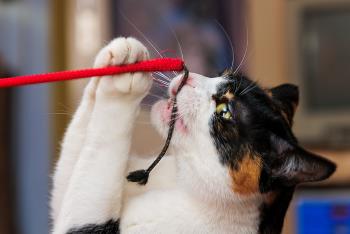Do you have a cat who is shy? One who is timid and insecure and constantly hides under the bed? Maybe among your several cats there is one who never interacts with others? In this article, you will learn to communicate with a shy cat effectively and how to boost confidence in insecure cats.

IMPORTANT: You should be able to distinguish a cat who is in chronic stress from a one that is just timid. A stressed cat can be identified by certain symptoms and a possible source. You can learn more about stress in cats here.
- Do not force things to happen. Your cat is shy not because this is his style, but because this is who he is—a timid cat. At least for now. Forcing him to communicate with you or with other cats more than he wants to will have the reverse effect. Take a slow approach, and do not bother your cat unnecessarily; focus on creating a calm environment for him (see the next point). It’s okay to interact, to play with or pet your cat; just do it only as long as he finds it comfortable. But for the rest of the time, become almost transparent to your cat. Be in the same room, and do whatever you have to, but do not pay attention to him. Act normally. If you have more than one cat, try to make a private corner for the more shy one to hang out. If necessary, you can also separate your cats completely, until the shy cat builds confidence.

- Make your cat’s surroundings calm and stimulating. Most important, create opportunities and places to climb and jump. Being aboveground is a huge confidence booster for insecure cats. The quickest solution is adding a cat tree or two. Window perches, shelves and the tops of regular furniture are also great. Find more tips to make your house a cat’s dream here. At the same time, make sure your cat does not have the ability to hide under the bed or behind other furniture where she is not able to see what’s going on. It’s simply dreadful to hear footsteps without seeing who’s approaching. Block access to these spots, or even remove them for now, if possible.
- Make things easily accessible and plentiful. By this we mean litter boxes, food bowls, water bowls, napping locations, cat trees, playing opportunities and any other things that cats interact with. Provide them in different parts of your home, so that a timid cat can have everything she needs nearby, without the need to pull her courage together to reach the water bowl. This is especially important if you have more than one cat. The litter box, for example, is a common location where bullying cats try to ambush shyer ones. This is not good, and you need to do everything to prevent it, which can be done by providing several litterboxes in different parts of your home.
- Feed your cats individual meals, and feed the shy one separately. This correlates with the previous point, because food is a very important resource for cats. Food creates a lot of competition and tension, which is easily removed if you feed your cats at individual meals, from separate bowls and in separate rooms. Leaving free access to food is a bad setup in these circumstances.
- Play with your cat often. Playing has many benefits, and when done right, it becomes a serious confidence booster for shy cats. Why? Playing resembles hunting, and a cat who experiences it feels his natural cat inside. He feels that he is the mighty hunter, and guess what? Mighty hunters are not shy. They are determined.
When should you play with your cat? Good play times are before meals and after your cat wakes up. Bad times are all the other times, especially after meals, when the cat enters a “sleepy mood.”
How can you play with your cat? There are two main ways, interactive play and solo play.-

If a cat becomes a successful toy catcher, there is no place left to be shy. Photo by Tambako The Jaguar, ccInteractive play is where you direct a toy, for example, a mouse on a string or a feather on a stick. Don’t swing the toy in your cat’s face, and don’t move it chaotically. Slow motions that are directed away or past your cat are those that most encourage confident playing. This is like real prey would move. You can simulate a mouse, which runs along a wall and disappears behind the corner, or a bird, who flies from spot to spot, spends some time pecking grain, and then moves again. IMPORTANT: Let your cat catch and chew the toy occasionally. End the play session with a treat or a meal. If your cat feels insecure and does not feel like playing, do not push it. However, you can try to encourage her as described in this article.
- Solo play provides the possibility of engaging in play while the owner is not there. Balls, fake mice, toys on springs, toys that hang from the ceiling or doorway and catnip toys are used for this purpose. Some cats also play with non-toy items, like pen caps, child toys or toe spacers. Have several different toys available to your cat and rotate them frequently, so she does not become bored with them.
-
- Do not limit your cat unnecessarily. Rules are okay for creating order in your house. It’s okay to not want your cat on the counter top or to scratch your sofa. It’s almost okay to have an army regime in your house, but when dealing with a shy cat, it’s better only to deny things that are very important. Whenever you have to shoo your cat off something, it damages your achievement of making him less shy.
- If your cat is not allowed to do something, instead of shooing him away, try to catch his attention before he engages in the activity. You can keep your cat’s favorite bouncy ball in your pocket, and as soon as he approaches his favorite scratching chair, let the ball bounce by your cat. It’s likely he will chase after it, forgetting about his bad intentions.
The abovementioned things to help a shy cat gain confidence are pretty much independent from each other. Implementing just one will dramatically reduce your cat’s insecurity about the environment. Of course, the more good things as opposed to stressful things that there are in your cat’s life, the more success you will have.
Simultaneously, remember that patience is the most important ingredient, because confidence shouldn’t be boosted—it must be built.
